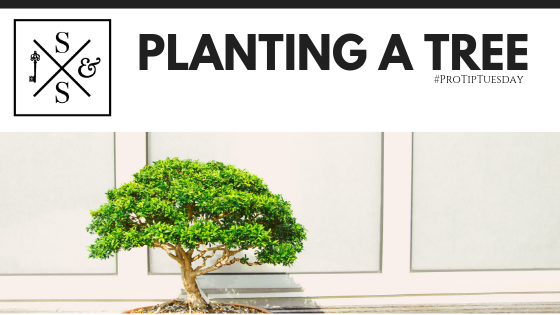
Planting a Tree
Now that spring has officially begun many of us are getting back out into our yards. This week we share some helpful tips about planting trees. The same applies to shrubs and larger plants.
- Location matters.
The type of tree and its desire or tolerance for sunlight will dictate the location within your lot, but the full-growth size of the plant is also a consideration. Trees that grow to 30 ft (or less) tall should be kept at least 10 ft from foundations and utility lines, 30-70 ft trees at least 15 ft away, and 70+ footers 20 or more ft away.
- Start with the correct sized hole.
Start with a hole at least twice the size of the root ball you will be planting, bigger is better. The width of the hole is key to root growth, healthy roots mean a fast growing and healthy tree. While it needs to be wide, ensure that the hole is not any deeper than the root ball to avoid settling. If the roots are bound, cut the strings and remove any burlap at least on the sides.
- Backfill with good soil.
For years it was suggested to include organic matter such as mulch or leaves in the soil, experts recently have determined that there is little to no benefit of doing this so long as the soil is good. What is important however, is not packing the soil to densely. The soil needs to be relatively loose to allow the roots to spread evenly, which is why the hole needs to be quite large. Carefully place the soil around the root ball, stopping periodically to ensure that the trunk is straight. Use any remaining soil to create a berm around the hole. This makes a sort of watering well.
- Install tree stakes.
The stakes should go straight down through the root ball into the firm ground beneath and be loosely attached to the trunk. If the stakes are bound to tightly it could cut into the tree’s bark. Larger trees may require several stakes to keep the trunk upright.
- Watering
You should water the tree each day for the first few weeks after planting. Fertilizer has a very limited benefit at the time of planting and could shock the roots. Watering can be reduced after a few weeks when the roots have had time to spread. A three-inch layer of mulch will keep weeds from growing around the tree’s base and reduce water loss at the surface. Fertilizer can be introduced after the tree is more established.
Bonus Tip: When a tree is small and young, pruning should be limited to removing dead, broken and diseased branches. Over-pruning should be avoided because it could be detrimental to growth. After the first growing season you can begin to prune for beautification.




